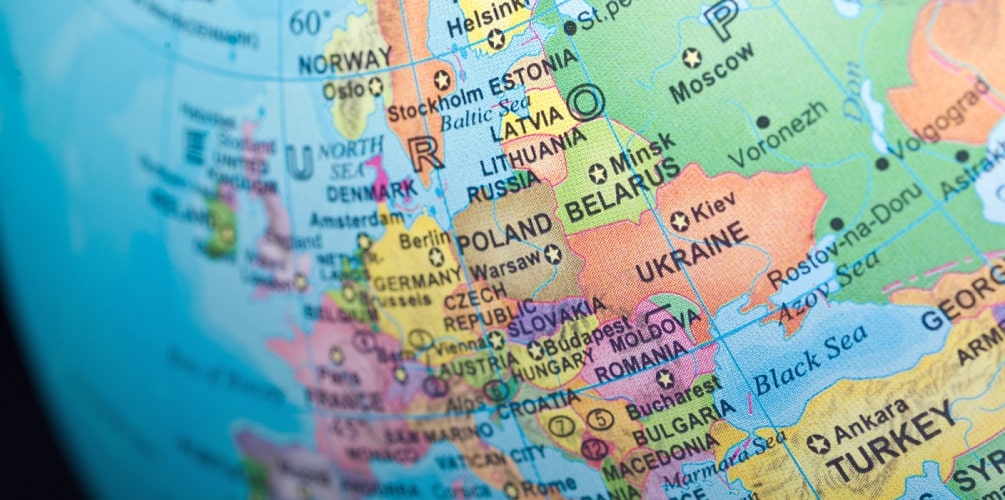The increasing tensions between Russia and Ukraine over the last few weeks have reached a boiling point on 24 February 2022 with the launch of military operations by Russia in Ukraine. Between the rise in the price of energy commodities and the declaration of economic sanctions recently imposed by several Western States on Russia, the full extent of the repercussions of the crisis is yet to be fully ascertained but its effects on the foreign exchange market are palpable across the board.
Implications on the global energy market
The effects of the Russia-Ukraine conflict are spilling into the global energy market. Russia is among the world’s leading producers and exporters of gas and oil. It is the world’s third largest oil exporter after Saudi Arabia and the United States and the second largest global gas producer after the United States. It is the main supplier of crude oil, natural gas and solid fossil fuels in Europe, making the EU particularly reliant on Russia for its energy supply. In fact, the European Union imports up to 40% of its needs from Russia via a network of pipelines that transit through Ukraine and Belarus.
With Covid-19 restrictions easing and economies recovering, the energy market is in strong demand and crude-oil prices across the world are seeing a slight increase. Since the start of the Russia-Ukraine crisis, energy prices in Europe have been on the rise. The crisis in Eastern Europe comes as an additional strain on the already stretched energy market especially given the recent economic sanctions imposed by Germany to suspend certification of the Nord Stream 2 pipeline project. Nord Stream 2 would see the creation of a pipeline under the Baltic Sea linking Russia directly to Western European markets via Germany. In response to the West’s sanctions, Russia could potentially retaliate by suspending its gas supply to the European Union, not to mention that fighting in Ukraine could potentially damage key infrastructure. Supply disruption could impact the price of oil as countries would likely switch away from natural gas. This in turn will likely further fuel inflation.
The rise and fall of commodity-based currencies
The dramatic increase in energy prices, and oil and natural gas in particular, strengthened the Russian ruble (RUB) and other commodity-currencies like the Canadian dollar (CAD) and the Norwegian krone (NOK) throughout 2021. Commodity-importing countries on the other hand, like Japan (JPY) and the United Kingdom (GBP), were negatively impacted. As the crisis unfolds however, commodity-based currencies are experiencing a sharp fall as gold and safe haven currencies like the Japanese yen (JPY) and the Swiss franc (CHF) are in high demand.
Geopolitical risks and sanctions hit Russia
In light of the rising tensions between Russia and Ukraine, an extraordinary G7 meeting was held between the United States and its allies to announce a range of economic sanctions on Russia:
- The United States announced a first set of sanctions on two of the country’s key financial institutions, several Russian oligarchs and its foreign debt.
- The European Union agreed on a range of measures intended to penalise members of Russia's upper house that had voted for the recognition of the two targeted Ukrainian regions as independent states. Germany halted the joint Russian-EU Nord Stream 2 gas pipeline project.
- The United Kingdom announced the freezing of five Russian banks that had their assets in the Britain and three Russian billionaires.
The impact on trade with Russia
Given the developments of the crisis and the current situation on the energy market in Europe in particular, what implications can be drawn on the currencies of countries trading with Russia?
According to data drawn from the IMF, Slovakia has the largest trade exposure to Russia among NATO member states, followed by The Netherlands. The eurozone’s trade exposure to Russia is also significant. Conversely, the trade exposure of non-euro member countries like Hungary, the Czech Republic and Poland is less important while the UK and the US have only limited trade exposure to Russia.
Russia on the other hand has increasingly been focusing on trade flows to the East to bolster its economy. In its efforts to reduce its reliance on the dollar, Russia has found a partner in China. The country’s exposure to China has grown significantly since 2014. In line with Russia’s dedollarisation effort, the two countries are shifting away from using the dollar in their bilateral trade.
How does this conflict compare with the events in 2014?
Russia already made headlines in 2014 with its annexation of Crimea. At the time, the United States and Western European countries had already imposed economic sanctions on the country, in particular by disconnecting Russia from the SWIFT system. Can we expect similar fluctuations on the forex market or will the Russian ruble fare differently this time?
As previously mentioned, the increase in the country’s key exports in 2021 amid higher global energy prices in gas and oil have strengthened the Russian currency. Russia currently has one of the lowest debt-to-GDP ratios in the world and a record-high current-account surplus.
While the ruble lost 40% of its value against the dollar in 2014 following economic sanctions and a drop in oil prices, the country has significantly bolstered its foreign currency reserves since then. In fact, its reserves have risen some 70% since 2014 and today, Russia has the fourth largest foreign currency reserves in the world after China, Japan, and Switzerland; reserves that should constitute a safety cushion in case of currency instability.
As the situation continues to unfold, all eyes are now on the Western response.
Topics






